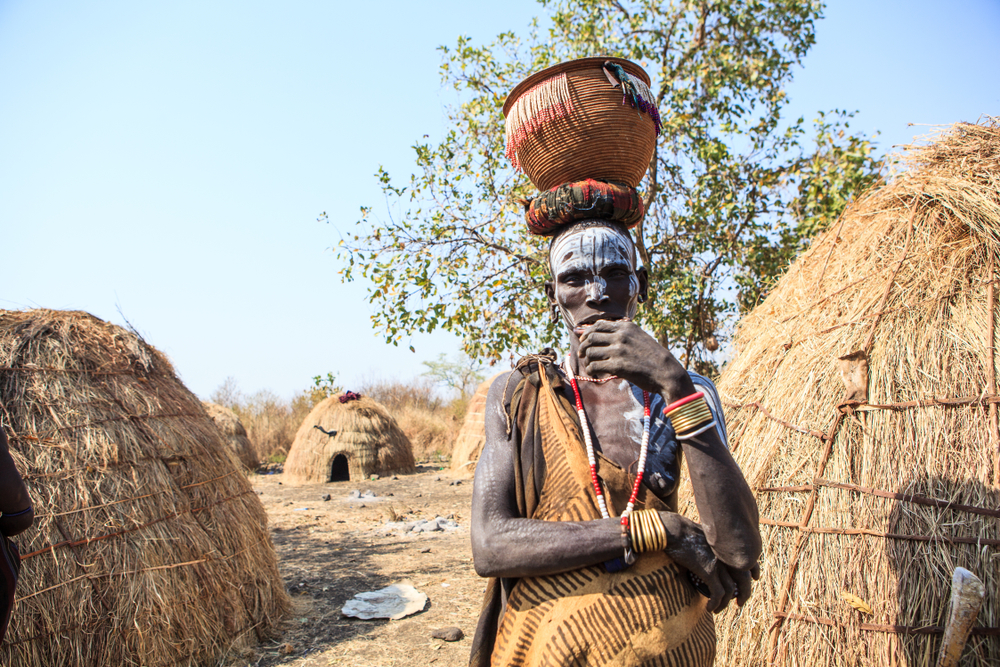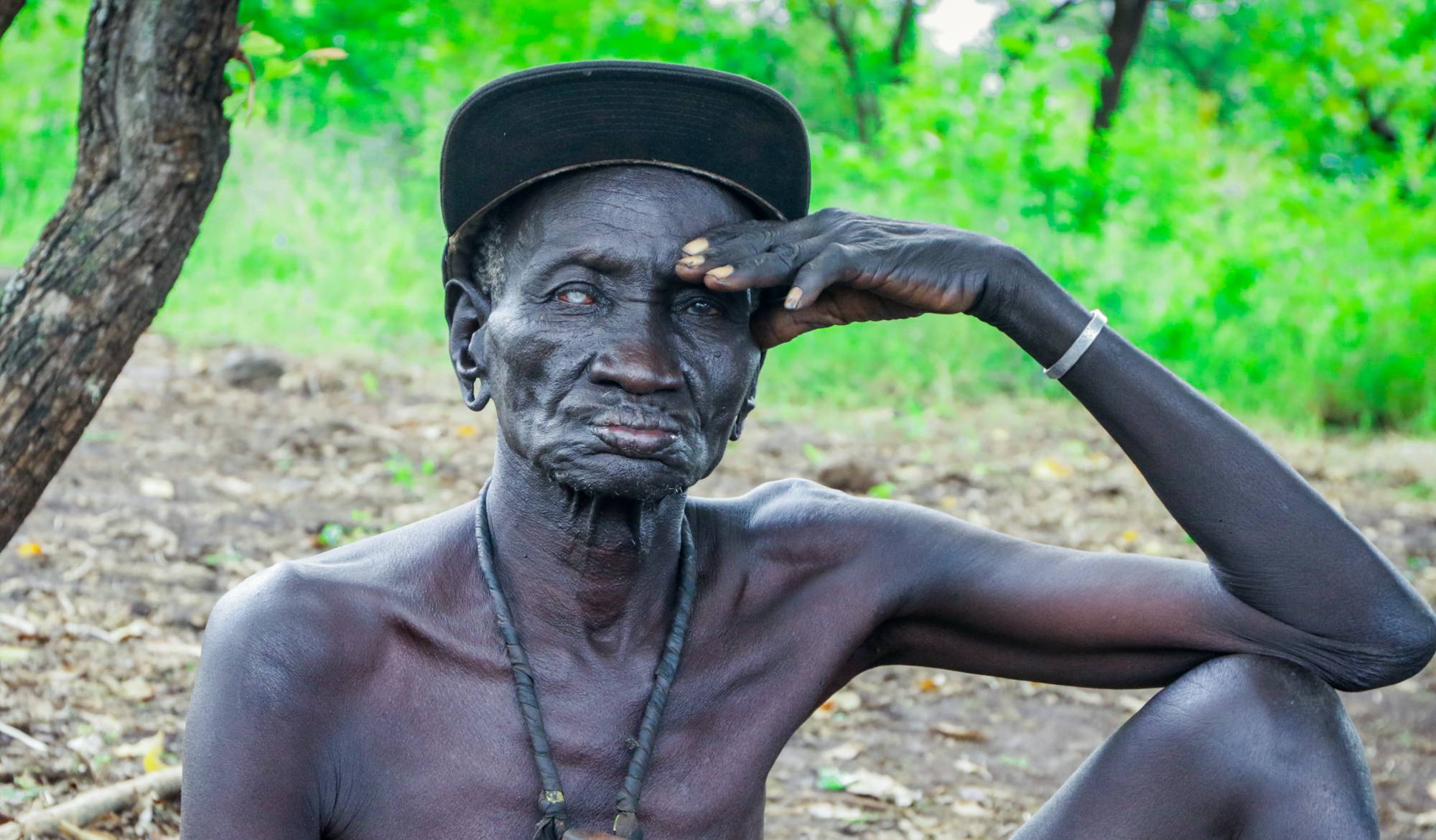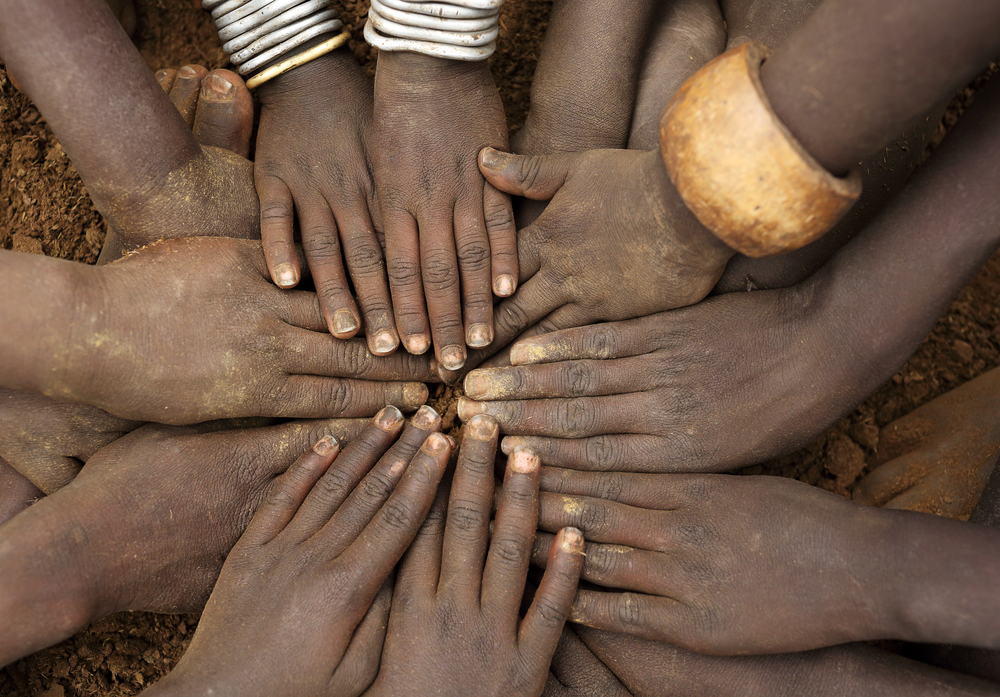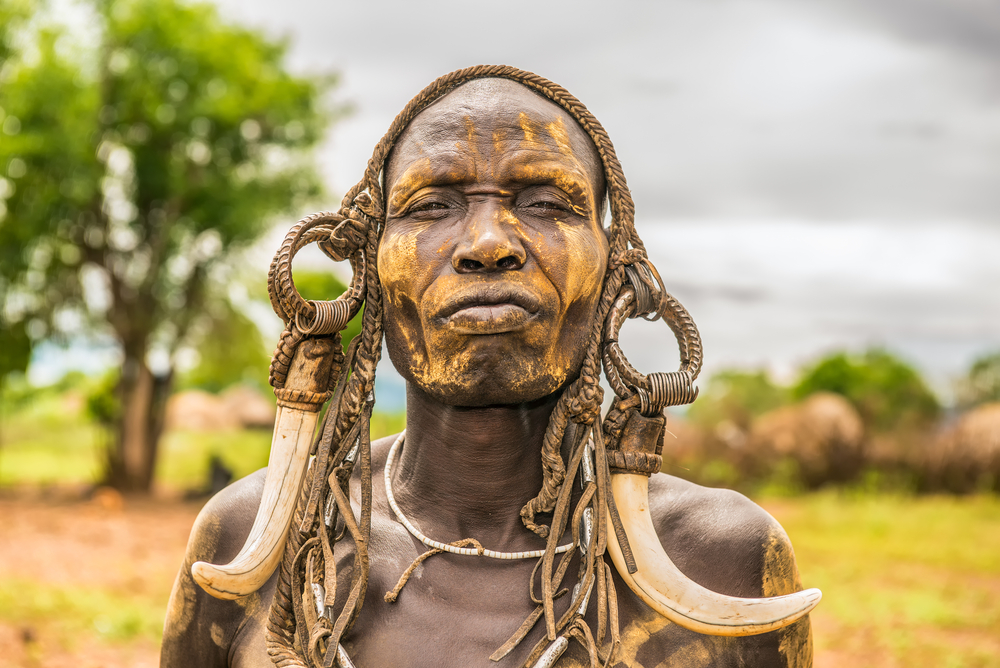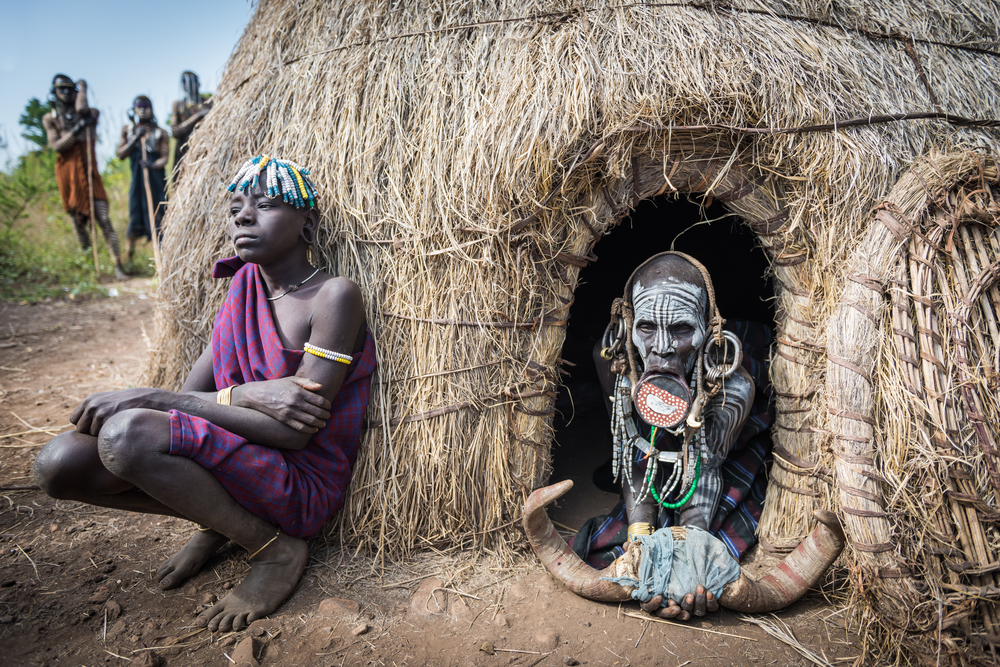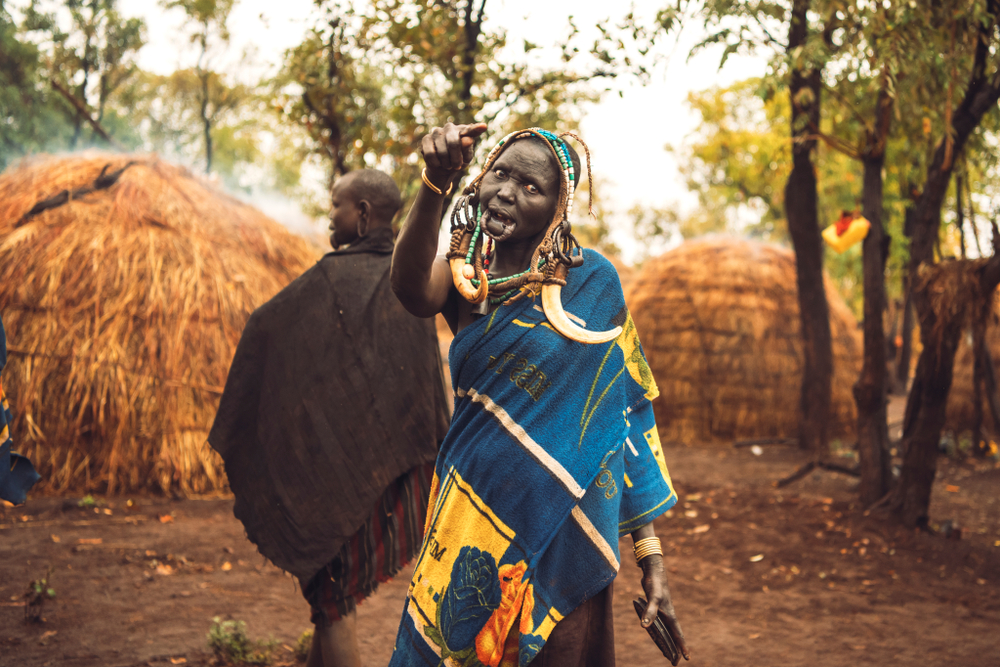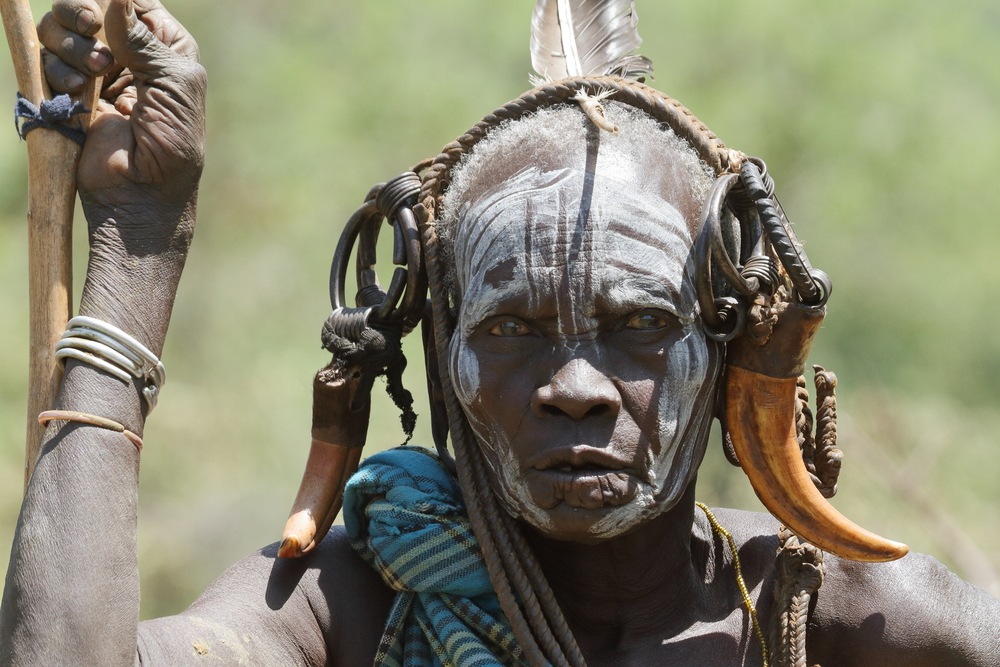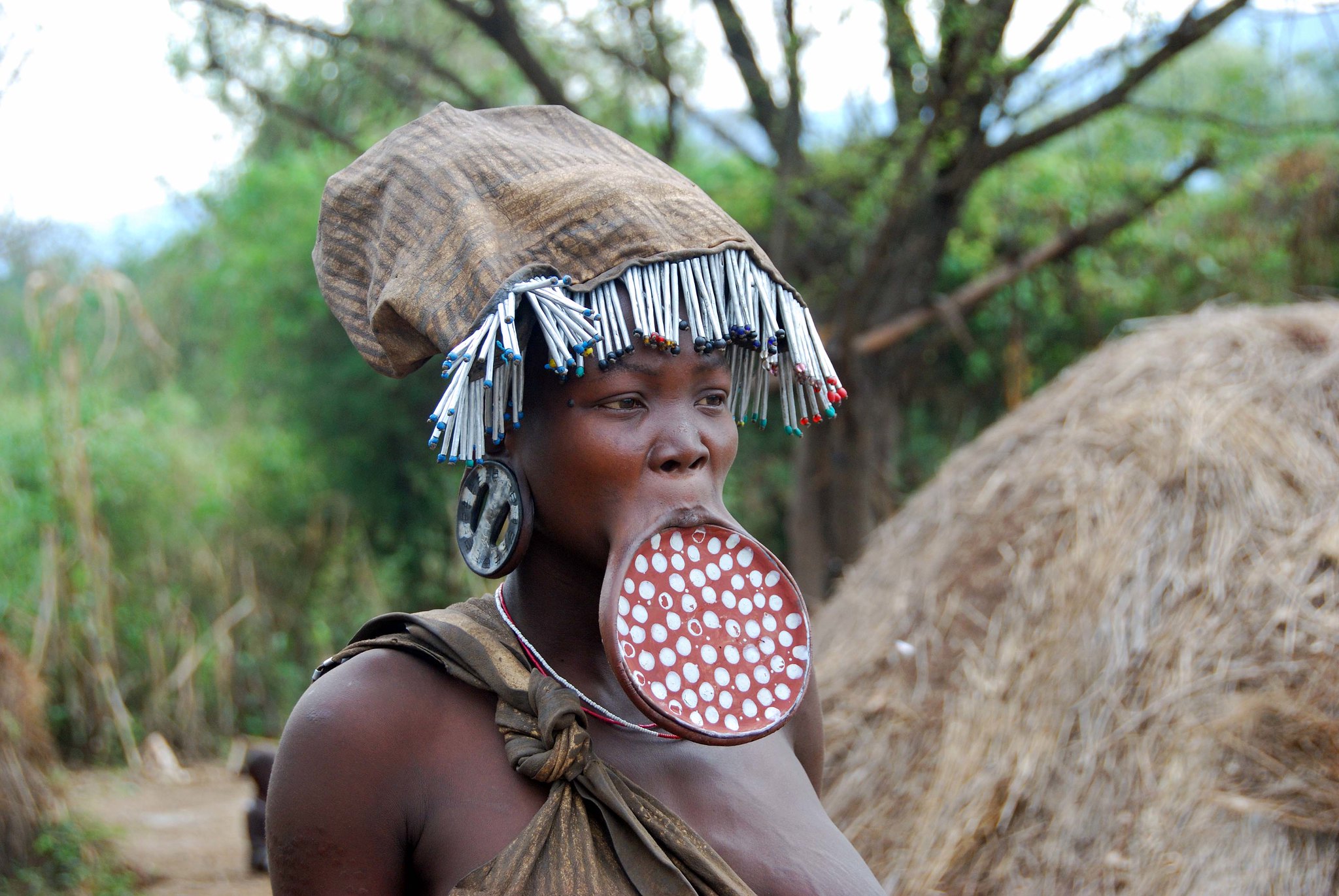Meet The Mursi People
The Mursi have become famous for their striking jewelry and controversial lip plates, but that's just the tip of the iceberg when it comes to this fascinating tribe.
Let's explore the vibrant world of the Mursi people.

The Mursi Homeland
The Mursi live near Ethiopia's border with South Sudan, in an area that is surrounded by mountains and situated between the Omo and Mago rivers.
It's one the most isolated places in Ethiopia. The Mursi call it Mursiland.
 Udofia fabulous, CC BY-SA 4.0, Wikimedia Commons
Udofia fabulous, CC BY-SA 4.0, Wikimedia Commons
Their Population Numbers
There are approximately 11,500 Mursi people, with most of the population living in their remote homeland. About 900 Mursi have chosen to live in cities.
What Do They Wear?
Traditionally, Mursi men would dress in a suit called a dobi. It's made from plant and tree bark that has been beaten until the fibers become thin and malleable.
In more recent times, men have worn a long piece of colorful fabric that's draped over their shoulder or around the waist.
What Do They Wear? (cont'd)
Mursi women have traditionally worn a goatskin skirt. In the past, many went without a covering on top, but now many were a cloth over their shoulder, to cover their bosoms.
 Rod Waddington, CC BY-SA 2.0, Wikimedia Commons
Rod Waddington, CC BY-SA 2.0, Wikimedia Commons
Their Jewelry
Mursi men and women wear lots of jewelry. Metal bracelets and anklets are common among the women, while men's bracelets are typically made of bone or wood with metal.
 Achilli Family | Journeys, Flickr
Achilli Family | Journeys, Flickr
Their Jewelry (cont'd)
It is common for Mursi men and women to wear wide clay earrings. Tusks and horns are also used.
The Lip Plate
Even today, many Mursi women choose to wear their iconic lip plate.
Made of pottery or wood, the lip plate is a sign of femininity and beauty and marks the transition from girlhood to womanhood. It can also signify a woman's marital status.
 Rod Waddington, CC BY-SA 2.0, Wikimedia Commons
Rod Waddington, CC BY-SA 2.0, Wikimedia Commons
The Lip Plate (cont'd)
Mursi girls start wearing a lip plate once they turn 15 or 16. The girl's mother will make a small incision in her lower lip and then insert a small plate.
Over the next few months, the girl will use increasingly larger plates until she reaches the ideal plate size.
 Rod Waddington, CC BY-SA 2.0, Wikimedia Commons
Rod Waddington, CC BY-SA 2.0, Wikimedia Commons
Do The Lip Plates Hurt?
For many outsiders, the lip plates are bizarre and have raised concerns about whether they they hurt the girls or cause health issues.
Luckily, the plate heals quickly. The lip plate will hurt for about three to six months after it's inserted. The Mursi use herbal ointments to prevent infection and aid healing.
 Rod Waddington, CC BY-SA 2.0, Wikimedia Commons
Rod Waddington, CC BY-SA 2.0, Wikimedia Commons
Do The Lip Plates Hurt? (cont'd)
Once the lip piercing has healed, it is not painful and does not cause any discomfort. The lip plate does have a minor effect on the woman's speech, like changing "s" sounds" to a "th" sounds.
Because of the weight of the lip plate, girls may also not run quite as fast, similar to how women in America are a bit slower when wearing high heels.
Mursi Body Modifications
Scarification is another method of body modification that is practiced by the Mursi. Ritual scarification for men is called riru, while women's scarification is called kitchoga.
 Rod Waddington, CC BY-SA 2.0, Wikimedia Commons
Rod Waddington, CC BY-SA 2.0, Wikimedia Commons
Mursi Body Paint
Body painting is very important to Mursi men. Sometimes they use it purely for aesthetic reasons, while other times, it has a medicinal purpose.
 Rod Waddington, CC BY-SA 2.0, Wikimedia Commons
Rod Waddington, CC BY-SA 2.0, Wikimedia Commons
Cow Dung Paint
Cow dung and clay are commonly used to as body paint. When a man paints himself in a mixture of cow dung and ash, it's meant to show people that he is an eligible bachelor, who is skilled at caring for his cattle.
Clay Paint
Clay paint is often used in healing rituals, since the Mursi believe that clay has medicinal properties.
Clay paint also protects their skin from the hot Ethiopian sun, and some varieties of clay, like white limestone, are natural insect repellants.
The Donga Ritual
To be considered men, Mursi boys must undergo the Donga ritual. This is a ceremonial fight, where boys challenge each other to a duel with a long stick called a Donga.
The person who knocks their opponent down or forces them to retreat is the winner.
The Donga Ritual (cont'd)
Elders in the community referee the Donga ritual, making sure the boys fight with honor.
The boys spending many years preparing for this fight, which signifies that they can protect their family and carry out their responsibilities as men.
Their Spiritual Beliefs
The Mursi believe in a higher power called Tumwi. Tumwi lives in the sky and it sometimes manifests itself as things that relate to the sky, like birds or rainbows.
 lucrezia senserini88, Shutterstock
lucrezia senserini88, Shutterstock
The Shamans
Shamans play an important role in Mursi society. Called Komoru, the shaman inherits their role and is seen as mediator between Tumwi and the people.
The Shamans (cont'd)
The shaman's main duty is to perform rituals that helps protect the tribe.
Rituals to protect crops from pests, bring rain, and ward off enemy tribes are some of the more common ceremonies a shaman is responsible for.
The Shamans (cont'd)
The Mursi believe that Komoru should not leave Mursiland, for this would threaten the connection between the people and Tumwi.
Some Mursi even go so far as to say that the shamans can't ever be apart from their clan.
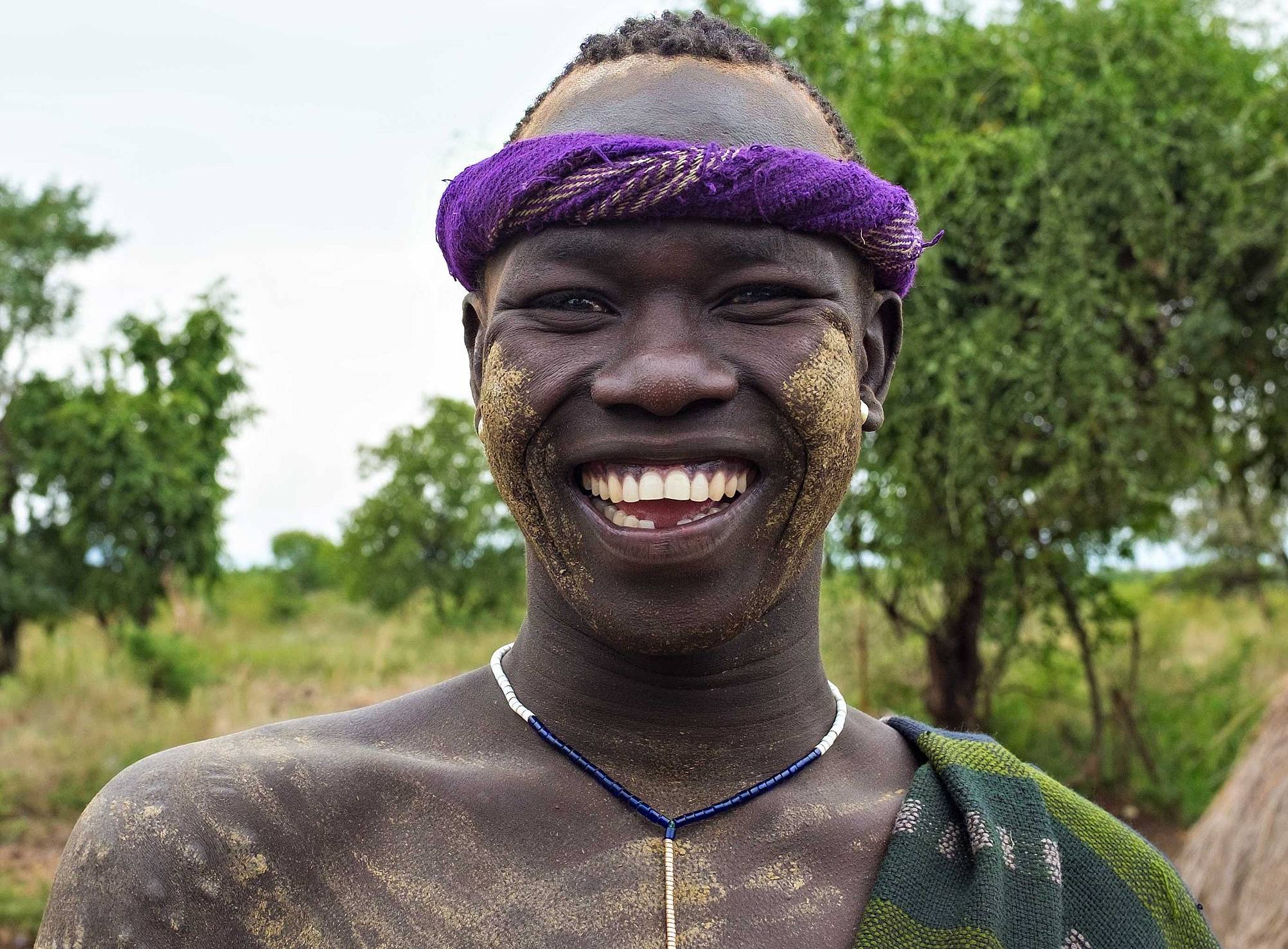 Rod Waddington , CC BY-SA 2.0, Wikimedia Commons
Rod Waddington , CC BY-SA 2.0, Wikimedia Commons
The Bio Lama Ritual
Bio Lama, meaning "rounding up the cattle", is the Mursi's most important ritual, meant to invoke good health for the people and cattle and fertility for the land.
Shamans usually perform their rituals in private, but the whole community takes part of the Bio Lama ritual.
The Bio Lama Ritual (cont'd)
During the Bio Lama ritual, people mix various colored clays with water to create a paint-like mixture.
Everyone at the ceremony is marked with paint, while the Komoru burns tree leaves. The Mursi believe the smoke will gain the attention of Tumwi.
How Long Is The Ritual?
The Bio Lama ritual lasts for four days and involves sacrificing some of the community's cattle and goats.
Rainfall during the ritual or soon afterward is seen as a sign of the Komoru's power.
The Mystical Healers
Similar to shaman, female healers called Ngerre also have an important role in Mursi communities.
These healers are more like sorceresses as, unlike traditional healers called Nani, the Ngerre cure people of curses or ailments caused by the higher power Tumwi.
The Mystical Healers (cont'd)
The Ngerre uses various rituals to diagnose and cure these supernatural illnesses. When she's done, she takes payment in the form of beer, coffee, goats, or money.
Sacred Clay
Clay is an important part of Mursi rituals. The clay in their homeland comes in various colors and some clay pits are considered sacred.
Only the shamans can go to the sacred pits or allow others from the clan to do so.
Why Is Clay Sacred?
Clay and ash are sacred to the Mursi because they believe these earthly properties can absorb and cleanse harmful energies.
This is different from water, which is often considered dangerous because they believe it can cause contamination and spread infections.
Rites Of Passage
Throughout their lives, the Mursi will experience several rights of passage, but the Donga ritual and the lip plate are the most important.
The lip plate is also the aspect of Mursi culture that has gained the attention of tourists worldwide.
 Lourdeschr, CC BY-SA 4.0, Wikimedia Commons
Lourdeschr, CC BY-SA 4.0, Wikimedia Commons
Age Sets
"Age sets" are an important part of social organization in Mursi communities. Men are organized into age sets that determine their roles in the community and communal decision-making.
Throughout their life, they will pass through several different age sets. When women get married, they become part of their husband's age set.
What Language Do They Speak?
The Mursi's language is named after the tribe. There are two ways of writing their language.
One is with an Amharic-based alphabet, which is more difficult to write, and the other alphabet is based on Latin and is easier to learn.
What Do They Eat?
The Mursi are excellent farmers. Their main crop is sorghum, a type of grain that is used to make thick porridge.
Beans, chickpeas, and maize are also common crops on Mursi farms.
Mursi Marriage
Before Mursi couples can get married, they must perform three different rituals: the bride-price ritual, the duri ceremony, and the rite of tugha.
In the bride-price ritual, the prospective husband must arrange a price to paid for his wife. The man pays the bride's family to compensate them for the loss of labour that occurs from her moving away from them.
Mursi Marriage (cont'd)
The bride-price is paid in cattle. Giving 38 head of cattle is customary and the livestock will be divided among the bride's closest relatives.
It is also customary for an AK-47 to be included in the bride-price, and this goes to the bride's father.
The Kidong Ko Duri Ritual
Once the bride-price has been settled, the community hosts the Kidong Ko Duri ritual, called Duri for short.
This a full day of dancing and singing as everyone wishes the new couple well. Games and theater skits about married life are also part of this joyous day.
The Tugha Ceremony
The Tugha is the last ceremony before the wedding. During this ceremony, the prospective bride receives her father's blessing and consent to marry.
This act is seen as a rite of passage for Mursi women, as they make the transition from daughter to wife, and accept responsibility for their new family with their husband.
 Rod Waddington, CC BY-SA 2.0, Wikimedia Commons
Rod Waddington, CC BY-SA 2.0, Wikimedia Commons
Choosing The Right Partner
Mursi marriages aren't typically arranged but there are some rules about who one can choose as a partner.
People cannot marry someone from their own clan since this is seen as marrying a family member. Mursi also cannot marry someone from a rival clan, as this is seen is bad luck.
 Rod Waddington, CC BY-SA 2.0, Wikimedia Commons
Rod Waddington, CC BY-SA 2.0, Wikimedia Commons
Issues In The Modern World
Much of the Mursi traditional homeland is part of the Omo National Park. In 2005, legal changes to the park's boundaries caused the Mursi and other tribes, like the Suri and Nyangatom, to be seen as illegal squatters on the land.
To move these people off the land, park officials coerced them into signing legal documents that could not read.
 Bernard Gagnon, CC BY-SA 3.0, Wikimedia Commons
Bernard Gagnon, CC BY-SA 3.0, Wikimedia Commons
Issues In The Modern World (cont'd)
After growing pressure from human rights organizations, the Mursi were allowed to stay on their land uncontested.
Since 2008, they have declared their territory to be a community conservation area, and they've started their own tourism project.
Tourism
The lip plates worn by Mursi women have made them popular with tourists. The tribe near the town of Jinka are the most visited and are known for their friendliness.
Final Thoughts
The Mursi may have gained the world's attention for their strange jewelry, but their story is one of resilience and resistance in the face of modern challenges.
Still beloved by tourist worldwide, the Mursi hold steadfast to their traditions and remain an example of how Indigenous cultures only make our world that much brighter.







